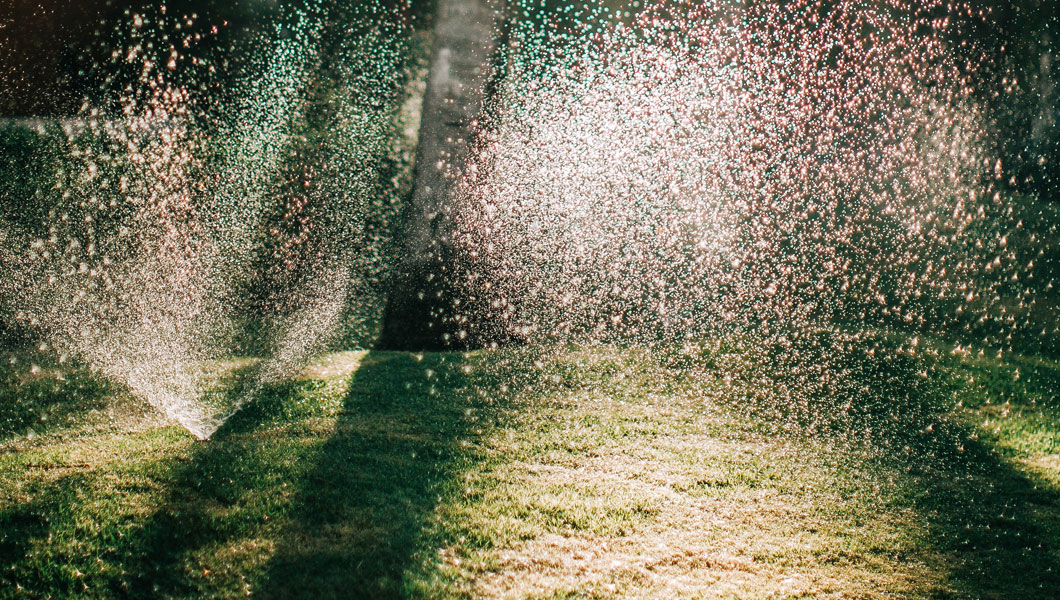
Category: Tips
When to Water Your Grass and How Much
Water is essential to all life … too little water and we die, too much and we drown. The same is true of grass. Water makes up 70% to 80% of the weight of lawn grasses and the clippings alone are nearly 90% water. While most people are concerned about not watering their lawns enough, the fact is that more lawns are damaged or destroyed by over-watering.
Newly installed turf grass sod has very important watering needs. Proper watering immediately after installation will ensure the turf gets established and it will also have an impact on how well the lawn continues to flourish for years to come.
When to Water New Sod
Begin watering new turf grass sod within a half hour after it is laid on the soil. Apply at least 2 to 3 cm. (1 inch) of water so that the soil beneath the turf is very wet. Ideally, the soil 7 to 10 cm. (3 to 4 inches) below the surface should be moist.
Watering Tip #1: Pull a corner of the turf and push a screwdriver or other sharp tool into the soil. It should push in easily and have moisture along the first 7 to 10 cm. (3 or 4 inches), or you need to apply more water.
Watering Tip #2: Make absolutely certain that water is getting to all areas of your new lawn, regardless of the type of sprinkling system you use. Corners and edges are easily missed by many sprinklers and are particularly vulnerable to drying out faster than the center portion of your lawn. Also, areas near buildings dry out faster because of reflected heat and may require more water.
Watering Tip #3: Runoff may occur on some soils and sloped areas before the soil is adequately moist. To conserve water and ensure adequate soak-in, turn off the water when runoff begins, wait 30-minutes to an hour and restart the watering on the same area, repeating this start-and-stop process, until proper soil moisture is achieved.
For the next two weeks keep the below-turf soil surface moist with daily (or more frequent) watering. Especially hot, dry or windy periods will necessitate increased watering amounts and frequency.
Watering Tip #4: As the turf starts to knit its new roots into the soil, it will be difficult, impossible and/or harmful to pull a corner to check beneath the turf (Watering Tip #1), but you can still use a sharp tool to check moisture depth by pushing it through the turf and into the soil.
Watering Tip #5: Water as early in the morning as possible to take advantage of the daily start of the grass’s normal growing cycle, usually lower wind speeds and considerably less loss of water because of high temperature evaporation.
Watering Tip #6: If the temperature approaches 100ºF (37ºC), or high winds are constant for more than half of the day, reduce the temperature of the turf surface by lightly sprinkling (syringe) the area. This sprinkling does not replace the need for longer, deeper watering, which will become even more critical to continue during adverse weather conditions.
During the rest of the growing season, most lawns will grow very well with a maximum total of one inch of water a week, coming either from rain or applied water. This amount of water, properly applied, is all that is required for the health of the grass, providing it is applied evenly and saturates the underlying soil to a depth of 10 to 15 cm (4 to 6 inches).
How to Water New Sod
Proper watering techniques are a critical aspect of lawn watering, equal in importance to the issues of when to water and how much to water. Here are several key factors to proper technique:
Avoid hand sprinkling because it cannot provide the necessary uniformity, as most people do not have the patience, time or “eye” to adequately measure what is being applied across any larger areas of lawn. The only possible exception to this guideline would be the need to syringe the surface of the grass to cool it, or to provide additional water near buildings or other heat-reflecting surfaces.
Understand the advantages and disadvantages of different sprinkler designs. The type of sprinkler you select will determine its proper use.
Follow these steps:
Step #1: Arrange cans at random distances away from any sprinkler, but all within the area you assume is being covered;
Step #2: Run the sprinkler for a specific amount of time, say a half-hour OR run the water until a specific amount of water is in at least one can, say a 1.5 cm (0.5 inches)
Step #3: Measure the amount of water in each can, checking for uniformity. Some variation is expected, but a 10% difference or more between any two cans calls for replacing or adjusting the sprinkler or relocating the system.
How much water is applied and needed
One inch a week is the standard water requirement established for most lawns; however, this will vary between different turf species and even among cultivars within a species. There will also be varying water requirements for seasonal changes and still more differences brought about because of different soil types.
Look at your lawn to determine its water needs. Grass in need of water will have a grey-blue cast to it, rather than a blue-green or green color. Also, footprints will still appear after a half-hour or more on a lawn in need of water, while on a well-watered lawn footprints will completely disappear within minutes.